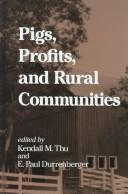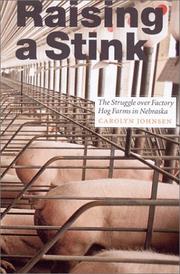| Listing 1 - 10 of 39 | << page >> |
Sort by
|
Book
ISBN: 153811075X 9781538110751 9781538110744 Year: 2018 Publisher: Lanham, Maryland : Rowman & Littlefield,
Abstract | Keywords | Export | Availability | Bookmark
 Loading...
Loading...Choose an application
- Reference Manager
- EndNote
- RefWorks (Direct export to RefWorks)
Pigs, Pork, andHeartland Hogs is an engaging celebration of the 12,000-year connection between humans and the world's most commonly consumed meat: pork. Throughout history, pigs shaped cultures and cuisines. Introduced into the Americas, they changed lives and, in time, helped define the Midwest, reflecting the region's diversity and abundance.
Periodical
Abstract | Keywords | Export | Availability | Bookmark
 Loading...
Loading...Choose an application
- Reference Manager
- EndNote
- RefWorks (Direct export to RefWorks)
Periodical
Abstract | Keywords | Export | Availability | Bookmark
 Loading...
Loading...Choose an application
- Reference Manager
- EndNote
- RefWorks (Direct export to RefWorks)
Pork industry and trade --- Swine --- Porc (Viande) --- Porcs --- Industrie --- Spain.

ISBN: 0585092893 9780585092898 0791438872 0791438880 1438422091 9780791438886 9780791438879 Year: 1998 Publisher: Albany : State University of New York Press,
Abstract | Keywords | Export | Availability | Bookmark
 Loading...
Loading...Choose an application
- Reference Manager
- EndNote
- RefWorks (Direct export to RefWorks)
Swine --- Pork industry and trade --- Pork packing --- Meat industry and trade --- Environmental aspects --- United States --- Rural conditions. --- Rural conditions --- Swine - United States --- Pork industry and trade - Environmental aspects - United States --- United States - Rural conditions
Book
ISBN: 1789854083 1789854075 1839620110 Year: 2019 Publisher: IntechOpen
Abstract | Keywords | Export | Availability | Bookmark
 Loading...
Loading...Choose an application
- Reference Manager
- EndNote
- RefWorks (Direct export to RefWorks)
Local or autochthonous pig breeds represent a pool of genetic diversity of porcine species and a link with old-style traditional production systems and traditional pork products. These breeds were largely abandoned because they were not competitive in the concept of modern, industrial type of pig production. Despite an increased interest for local pig breeds in the past years, they remain largely untapped and the knowledge about their characteristics is limited, which was a challenge undertook in the project TREASURE in the frame of multicriteria evaluation of local pig breeds. The book represents a valuable compendium of data on census, breeding organisations, production systems, and performances with ambition to present their contemporary (preserved) phenotype.
This work has received funding from the European Union’s Horizon 2020 research and innovation programme under grant agreement No 634476 for project with acronym TREASURE. The content of this book reflects only the authors' view and the European Union Agency is not responsible for any use that may be made of the information it contains.
Swine --- Pork industry and trade --- Breeding. --- Pork packing --- Meat industry and trade --- Swine breeding --- Veterinary Medicine and Science --- Animal Science --- Health Sciences
Book
ISBN: 0128096802 0128095989 9780128096802 9780128095980 Year: 2016 Publisher: San Diego : Elsevier Science & Technology,
Abstract | Keywords | Export | Availability | Bookmark
 Loading...
Loading...Choose an application
- Reference Manager
- EndNote
- RefWorks (Direct export to RefWorks)
Sausages. --- Meat --- Meat industry and trade. --- Preservation. --- Meat consumption --- Packing industry --- Food industry and trade --- Pork
Book
ISBN: 0295747315 9780295747316 Year: 2020 Publisher: Seattle, Washington : University of Washington Press,
Abstract | Keywords | Export | Availability | Bookmark
 Loading...
Loading...Choose an application
- Reference Manager
- EndNote
- RefWorks (Direct export to RefWorks)
The pig played a fundamental role in the German Democratic Republic's attempts to create and sustain a modern, industrial food system built on communist principles. By the mid-1980s, East Germany produced more pork per capita than West Germany and the UK, while also suffering myriad unintended consequences of this centrally planned practice: manure pollution, animal disease, and rolling food shortages. 0The pig is an incredibly adaptive animal, and historian Thomas Fleischman uncovers three types of pig that played roles in this history: the industrial pig, remade to suit the conditions of factory farming; the wild boar, whose overpopulation was a side effect of agricultural development rather than a conservation success story; and the garden pig, reflective of the regime's growing acceptance of private, small-scale farming within the planned economy.0Fleischman chronicles East Germany's journey from family farms to factory farms, explaining how communist principles shaped the adoption of industrial agriculture practices. More broadly, Fleischman argues that agriculture under communism came to reflect standard practices of capitalist agriculture, and that the pork industry provides a clear illustration of this convergence. His analysis sheds light on the causes of the country's environmental and political collapse in 1989 and offers a warning about the high cost of cheap food in the present and future.
Agriculture and state. --- Agriculture and state --- Communism and agriculture. --- Pork industry and trade. --- Swine --- Breeding.
Book
ISBN: 0813164885 0813155290 1322601151 9780813164885 9780813155296 Year: 1982 Publisher: Lexington, Kentucky : The University Press of Kentucky,
Abstract | Keywords | Export | Availability | Bookmark
 Loading...
Loading...Choose an application
- Reference Manager
- EndNote
- RefWorks (Direct export to RefWorks)
The history of the meat packing industry of the Midwest offers an excellent illustration of the growth and development of the economy of that major industrial region. In the course of one generation, meat packing matured from a small-scale, part-time activity to a specialized manufacturing operation. Margaret Walsh's pioneering study traces the course of that development, shedding light on an unexamined aspect of America's economic history.As the Midwest emerged from the frontier period during the 1840s and 1850s, the growing urban demand for meat products led to the development of a seasonal
Packing-houses --- Meat industry and trade --- Pork industry and trade --- Meat packing industry --- Packing industry --- Red meat processing plants --- Food processing plants --- Meat consumption --- Food industry and trade --- Pork packing --- History. --- History --- E-books

ISBN: 0803203306 9780803203303 0803276176 9780803276178 1280465794 9781280465796 9786610465798 6610465797 Year: 2003 Volume: v. 15 Publisher: Lincoln: Baltimore, Md. : University of Nebraska Press, Project MUSE,
Abstract | Keywords | Export | Availability | Bookmark
 Loading...
Loading...Choose an application
- Reference Manager
- EndNote
- RefWorks (Direct export to RefWorks)
"In Nebraska, as in many states across the nation, factory farms housing tens of thousands of hogs have altered the physical, cultural, and economic landscape, and have generated complex and deeply divisive conflicts among family farmers, environmentalists, agri-businesses, and elected officials. A reporter long familiar with the controversy, Carolyn Johnsen draws on a wealth of interviews, archival material, and her own extensive experience as a journalist to present a timely, informative, and balanced account of this complicated and troubling agricultural practice - and to put a human face on its causes and consequences." "Here everyone has a say: farmers and neighbors suffering from proximity to the factory hog farms; pork producers adopting the latest hog confinement technology in the face of fierce opposition; politicians attempting to interpret the "science" and shape public policy in a maelstrom. The result is the story of a struggle for the heart and soul of rural America."--Jacket.
Pork industry and trade --- Swine --- Pork packing --- Meat industry and trade --- Domestic pig --- Hogs --- Pig --- Pig farming --- Pigs --- Sus domestica --- Sus domesticus --- Sus scrofa domestica --- Sus scrofa domesticus --- Livestock --- Sus --- Economic aspects
Book
ISBN: 1855737159 9786610373291 1280373296 1855737167 9781855737167 0203498682 9780203498682 9781855737150 9781280373299 Year: 2003 Publisher: Cambridge : Woodhead,
Abstract | Keywords | Export | Availability | Bookmark
 Loading...
Loading...Choose an application
- Reference Manager
- EndNote
- RefWorks (Direct export to RefWorks)
Sausage manufacture: principles and practice provides a concise and authoritative guide to manufacturing high-quality products for the consumer. It begins by considering issues of definition and the market trends which determine how consumers define quality. The book then discusses product formulation, describing the essential recipe information for the main types of sausage. The chapter also includes the calculations required for mandatory product labelling in the EU.Chapter 4 reviews the key stages in production from raw material procurement through chopping, filling and cooking to s
Sausages --- 664.6 --- Worsten : bereiding --- Pork --- Chemical engineering. --- Food science. --- Sausages. --- Industrial & Management Engineering --- Mechanical Engineering --- Engineering & Applied Sciences --- Food industry and trade.
| Listing 1 - 10 of 39 | << page >> |
Sort by
|

 Search
Search Feedback
Feedback About UniCat
About UniCat  Help
Help News
News